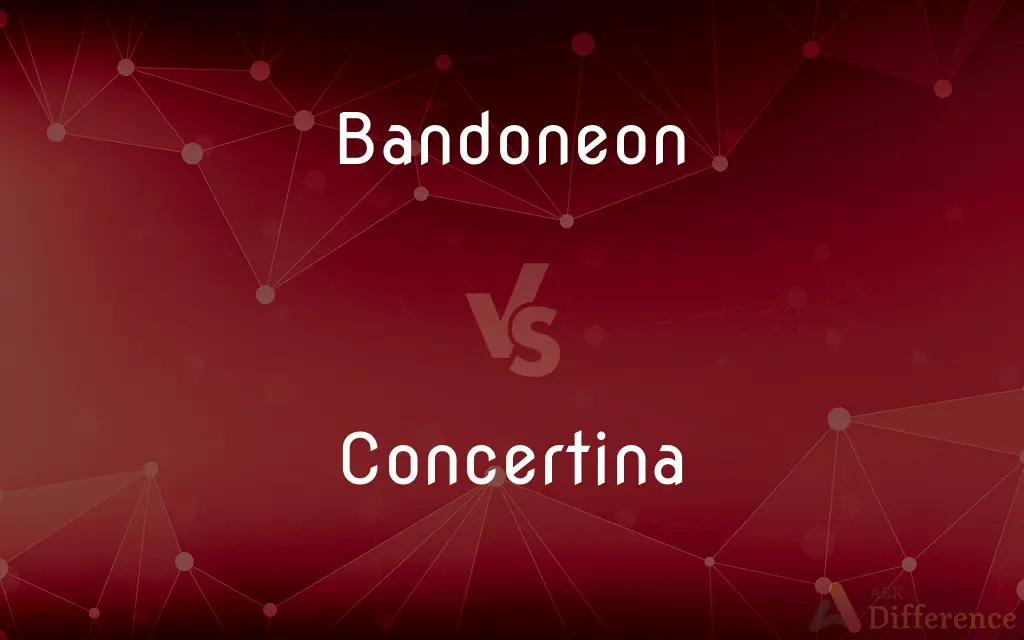Bandoneon vs. Concertina — What's the Difference?
Edited by Tayyaba Rehman — By Fiza Rafique — Updated on April 26, 2024
Bandoneon features a square shape with buttons on both sides, predominantly used in tango music; whereas the concertina, often hexagonal, is popular in folk music with buttons and bellows for producing sound.

Difference Between Bandoneon and Concertina
Table of Contents
ADVERTISEMENT
Key Differences
The bandoneon, originating in Germany, has become synonymous with Argentine tango music due to its deep, expressive sound. Whereas the concertina, first developed in England and Germany, is lighter in tone and often used in folk music across various cultures. Both instruments use bellows to produce sound but differ significantly in their musical expression.
Bandoneons are typically larger and more complex, equipped with more buttons which can total up to 72 or more. On the other hand, concertinas are generally smaller and more portable, with the number of buttons ranging from 20 to 40 depending on the type.
The layout of the bandoneon is non-uniform and quite challenging to learn, with different notes achievable on push and pull of the bellows. Conversely, concertinas usually have a more straightforward, uniform button arrangement that is often easier for beginners to master.
In terms of construction, the bandoneon has a square shape and is often made with wooden ends and a sophisticated reed mechanism that allows for a wide range of dynamics. In contrast, concertinas are typically hexagonal and can be made from wood, metal, or even plastic, affecting the instrument's sound and durability.
Regarding repertoire and playing style, bandoneon players often engage in intricate, emotive performances suitable for tango music. Whereas concertina players might be seen in more diverse contexts, from sea shanties to folk dances, benefiting from the instrument’s adaptability to various musical styles.
ADVERTISEMENT
Comparison Chart
Shape
Square
Often hexagonal
Origin
Germany
England and Germany
Main Use
Tango music
Folk music
Number of Buttons
Up to 72 or more
Typically 20 to 40
Note Arrangement
Non-uniform, changes with bellows
More uniform
Compare with Definitions
Bandoneon
A type of concertina popular in South America, especially associated with tango music.
The bandoneon player's skill added a soulful depth to the tango performance.
Concertina
Generally easier to learn than the bandoneon, with a more straightforward note system.
Beginners often start with the concertina due to its simpler mechanics.
Bandoneon
Known for its rich, sonorous tones, suitable for expressive music styles.
The bandoneon’s mournful sound perfectly captured the mood of the dance.
Concertina
Often hexagonal in shape, it is compact and portable.
The concertina, with its light build, was ideal for the traveling musician.
Bandoneon
A square-built accordion-like instrument with buttons on both ends.
He practiced daily, aspiring to master the complex bandoneon.
Concertina
Used in a variety of musical genres, particularly in English and Irish folk music.
The concertina added a lively spirit to the folk festival.
Bandoneon
Essential in traditional Argentine music ensembles.
A bandoneon is often the centerpiece in a classic tango orchestra.
Concertina
Available in different types such as English, Anglo, and Duet.
He preferred the Anglo concertina for its bisonoric qualities.
Bandoneon
Features a complicated button layout that can be daunting for novices.
Learning the bandoneon is challenging due to its intricate button system.
Concertina
A small musical instrument from the accordion family, played by pressing buttons and expanding or contracting bellows.
She carried her concertina everywhere, playing folk tunes at gatherings.
Bandoneon
The bandoneon (or bandonion, Spanish: bandoneón) is a type of concertina particularly popular in Argentina and Uruguay. It is a typical instrument in most tango ensembles.
Concertina
A concertina is a free-reed musical instrument, like the various accordions and the harmonica. It consists of expanding and contracting bellows, with buttons (or keys) usually on both ends, unlike accordion buttons, which are on the front.
Bandoneon
A musical instrument similar to a large concertina, especially popular in Latin America.
Concertina
A small instrument with bellows like an accordion but with buttons in place of keys.
Bandoneon
(musical instruments) A small Latin American accordion played with buttons which is frequently used in tango ensembles.
Concertina
(musical instruments) A musical instrument, like the various accordions, that is a member of the free-reed family of musical instruments, typically having buttons on both ends.
Concertina
Something resembling a concertina, such as a folded book, a bus door or a set of picture frames that are folded together.
Concertina
Coiled barbed wire for use as an obstacle.
Concertina
A type of booklet label, consisting of up to 32 pages of booklet as an insert.
Concertina
To become compressed into a shape reminiscent of a concertina
The car concertinaed into the wall.
Concertina
To be drawn closer and farther apart repeatedly, or up and down, as if situated on a working concertina's folds
Concertina
A small musical instrument on the principle of the accordion. It is a small elastic box, or bellows, having free reeds on the inside, and keys and handles on the outside of each of the two hexagonal heads.
Concertina
Coiled barbed wire used as an obstacle
Concertina
Free-reed instrument played like an accordion by pushing its ends together to force air through the reeds
Concertina
Collapse like a concertina
Common Curiosities
Can both instruments be used in tango music?
While both could technically be used, the bandoneon is the preferred choice in traditional tango music.
What is the main difference in shape between a bandoneon and a concertina?
The bandoneon is usually square, while concertinas are typically hexagonal.
Which instrument is more complex to play?
The bandoneon is generally more complex due to its non-uniform button layout and larger size.
Where did the bandoneon originate?
It originated in Germany and became popular in Argentina.
Are the button systems the same for both instruments?
No, the bandoneon has a more complex, non-uniform button system, while concertinas generally have a more uniform layout.
What types of concertinas are there?
There are several types including the English, Anglo, and Duet concertinas.
Which instrument is more portable?
The concertina is more portable due to its smaller size and lighter construction.
How do the sounds of these instruments differ?
The bandoneon produces a deeper, more expressive sound, ideal for tango, whereas the concertina has a lighter tone, more versatile in folk music.
What is the typical number of buttons on a concertina?
It varies, but typically ranges from 20 to 40 buttons.
Is one instrument better than the other for beginners?
The concertina is often considered better for beginners due to its simpler system.
Do both instruments change notes with the bellows' movement?
Yes, but the bandoneon’s note change is more complex due to its layout.
How important is the type of concertina chosen by a player?
It’s important as different types offer different features and sounds, suitable for various music styles.
What role does the bandoneon play in a tango orchestra?
It often serves as a central instrument, driving the emotive and dynamic aspects of the music.
What materials are used in making these instruments?
Both are made from combinations of wood, metal, and sometimes plastic.
Can concertinas be used in modern music genres?
Yes, concertinas are adaptable and can be used in various musical settings beyond folk.
Share Your Discovery

Previous Comparison
Curve vs. Turn
Next Comparison
Osteoplasty vs. OsteotomyAuthor Spotlight
Written by
Fiza RafiqueFiza Rafique is a skilled content writer at AskDifference.com, where she meticulously refines and enhances written pieces. Drawing from her vast editorial expertise, Fiza ensures clarity, accuracy, and precision in every article. Passionate about language, she continually seeks to elevate the quality of content for readers worldwide.
Edited by
Tayyaba RehmanTayyaba Rehman is a distinguished writer, currently serving as a primary contributor to askdifference.com. As a researcher in semantics and etymology, Tayyaba's passion for the complexity of languages and their distinctions has found a perfect home on the platform. Tayyaba delves into the intricacies of language, distinguishing between commonly confused words and phrases, thereby providing clarity for readers worldwide.














































